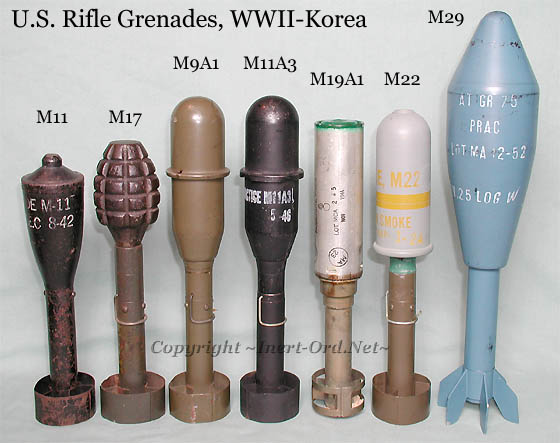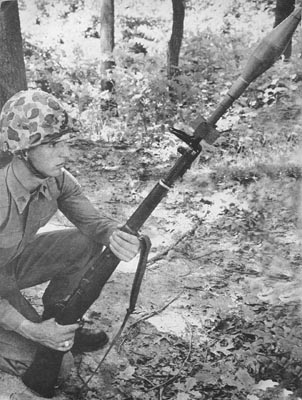
This is the practice version of the M9 anti-tank grenade. It consists of a cast iron head and a sheet metal tail assembly.
The M9 was the first U.S. anti-tank grenade. Although it used a shape charge warhead, the nose mounted impact fuze reduced its effectiveness. This also had problems with reliable detonation. These were only produced for about two years after its introduction in 1940. (Missing is a body mounted safety pin, similar to a hand grenade ring pin.)
M17, HE Fragmentation, Early WWII
This anti-personnel rifle grenade variation was used early in the war. It has a special stabilizing tail with an impact fuze and utilized the Mk.II grenade body for the warhead. It was discontinued by mid 1944 being replaced by the M1 “Projection Adapter” in conjunction with a standard Mk.II hand grenade. Early issues were painted yellow.
M9A1, HEAT
This was the standard High Explosive Anti Tank rifle grenade which replaced the M9. It is constructed of steel sheet
metal, utilizing a shaped charge with base detonating fuze. It weighed 1.31 lbs and could penetrate over 2 inches of armor. A very successful design that served very well against a variety of targets.
It was painted yellow until 1943 when the olive drab coloring scheme was used.
M11A3, Practice
Designed with replaceable components so that it may be easily repaired and re-used. This series included
the M11A1 thru M11A4, each successive model incorporating cost reducing features for manufacture as well as use.
M19A1, Signal, Ground, Green Star
This rifle grenade contains a single parachute supported flare with a 20-30 sec burn time. The tail boom contains a
supplemental propelling charge to help send the device to an altitude of about 200 yards. There is a cork stopper in the base to seal against moisture. A variety of colors and types were produced.
M22, Smoke
Introduced in the latter portion of the war, it was impact activated and provided approximately one minute of colored smoke, emitted from five holes at the base of the head. It shows the earlier paint scheme (yellow on gray). The color band at the neck of the shaft indicated the color of smoke, which was either red, yellow, green, or violet.
A related grenade, the M23A1, Smoke Streamer, was a 12 second signal which ignited almost immediately upon firing.
Air entered a hole in the nose and smoke was forced out holes in the base, producing a streamer of color. It looks similar, but lacks the detonating fuze and safety pin.
M29, Practice, 1950's
This is the practice version of the HEAT grenade M28. (More commonly found painted black.)
During the Korean war, the M9A1 was found lacking in performance, so the M28 copied the existing Belgian "Energa" design and was used until an improved grenade could be developed.
The 75mm diameter warhead could penetrate about 200mm (8in) of armor.
M31, HEAT & Practice. Post Korea - Vietnam
This grenade replaced the M29 and was the last type for the M1Garand. It continued to be used with the M14.
The fuze is self-arming when fired (no safety pin). It has an interesting piezoelectric initiator in the nose, which generates an electric pulse on impact. The pulse is transmitted through a small wire to the base detonating fuze.
This grenade could penetrate 10 inches of armor.

